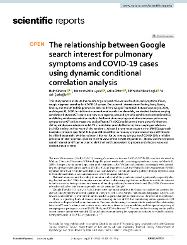| dc.contributor.author | Cinarka, Halit | |
| dc.contributor.author | Uysal, Mehmet Atilla | |
| dc.contributor.author | Cifter, Atilla | |
| dc.contributor.author | Niksarlioglu, Elif Yelda | |
| dc.contributor.author | Carkoglu, Asli | |
| dc.date.accessioned | 2023-10-19T15:12:09Z | |
| dc.date.available | 2023-10-19T15:12:09Z | |
| dc.date.issued | 2021 | |
| dc.identifier.issn | 2045-2322 | |
| dc.identifier.uri | https://doi.org/10.1038/s41598-021-93836-y | |
| dc.identifier.uri | https://hdl.handle.net/20.500.12469/5359 | |
| dc.description.abstract | This study aims to evaluate the monitoring and predictive value of web-based symptoms (fever, cough, dyspnea) searches for COVID-19 spread. Daily search interests from Turkey, Italy, Spain, France, and the United Kingdom were obtained from Google Trends (GT) between January 1, 2020, and August 31, 2020. In addition to conventional correlational models, we studied the time-varying correlation between GT search and new case reports; we used dynamic conditional correlation (DCC) and sliding windows correlation models. We found time-varying correlations between pulmonary symptoms on GT and new cases to be significant. The DCC model proved more powerful than the sliding windows correlation model. This model also provided better at time-varying correlations (r >= 0.90) during the first wave of the pandemic. We used a root means square error (RMSE) approach to attain symptom-specific shift days and showed that pulmonary symptom searches on GT should be shifted separately. Web-based search interest for pulmonary symptoms of COVID-19 is a reliable predictor of later reported cases for the first wave of the COVID-19 pandemic. Illness-specific symptom search interest on GT can be used to alert the healthcare system to prepare and allocate resources needed ahead of time. | en_US |
| dc.language.iso | eng | en_US |
| dc.publisher | Nature Research | en_US |
| dc.relation.ispartof | Scientific Reports | en_US |
| dc.rights | info:eu-repo/semantics/openAccess | en_US |
| dc.subject | Internet | En_Us |
| dc.subject | Trends | En_Us |
| dc.subject | Tool | En_Us |
| dc.title | The relationship between Google search interest for pulmonary symptoms and COVID-19 cases using dynamic conditional correlation analysis | en_US |
| dc.type | article | en_US |
| dc.authorid | Niksarlıoğlu, Elif Yelda/0000-0002-6119-6540 | |
| dc.authorid | Çınarka, Halit/0000-0002-4910-149X | |
| dc.authorid | Cifter, Atilla/0000-0002-4365-742X | |
| dc.authorid | UYSAL, MEHMET ATILLA/0000-0002-0430-498X | |
| dc.identifier.issue | 1 | en_US |
| dc.identifier.volume | 11 | en_US |
| dc.department | N/A | en_US |
| dc.identifier.wos | WOS:000675273800026 | en_US |
| dc.identifier.doi | 10.1038/s41598-021-93836-y | en_US |
| dc.identifier.scopus | 2-s2.0-85111078319 | en_US |
| dc.institutionauthor | N/A | |
| dc.relation.publicationcategory | Makale - Uluslararası Hakemli Dergi - Kurum Öğretim Elemanı | en_US |
| dc.authorwosid | Niksarlıoğlu, Elif Yelda/X-7048-2019 | |
| dc.authorwosid | Çınarka, Halit/AAK-6830-2021 | |
| dc.authorwosid | ÇARKOĞLU, ASLI/ABC-5996-2021 | |
| dc.authorwosid | Çarkoğlu, Aslı/GWM-7995-2022 | |
| dc.authorwosid | UYSAL, MEHMET ATILLA/P-1518-2015 | |
| dc.identifier.pmid | 34257381 | en_US |
| dc.khas | 20231019-WoS | en_US |
















